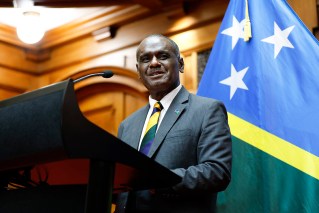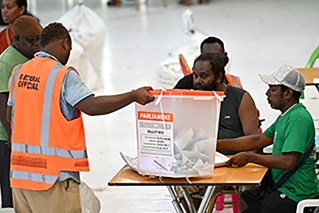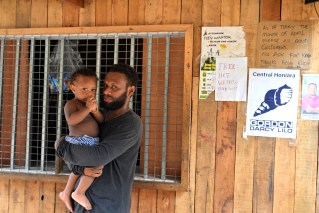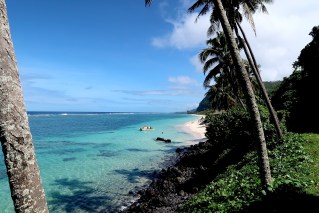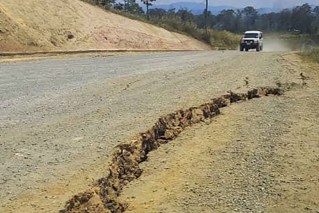Australian high commission roof collapses in Solomons quake


The area where Tuesday's earthquake struck.
The roof of Australia’s high commission in Honiara collapsed on Tuesday, after a powerful magnitude 7 earthquake and several strong aftershocks struck the Solomon Islands.
Prime Minister Anthony Albanese said there were no known injuries among high commission staff, but all had moved to higher ground after the tremor on Tuesday morning.
“The roof of the high commission has collapsed, which points to
likely damage throughout the city,” he said.
“Staff have been moved to higher ground because there was a tsunami warning that was issued. The high commission is seeking to confirm the safety of all Australians. There are difficulties because phone lines have gone down.”
The quake, which struck at 1pm AEDT, was centred 16 kilometres south-west of Malango at a depth of 15 kilometres, the United States Geological Survey said.
It initially put the magnitude of the quake at 7.3 before downgrading it.
The first tremor was followed by several aftershocks of between 5.1 and 6.1 within half an hour.
In the capital Honiara, there were reports of violent shaking that hurled items to the ground and knocked out power in some areas.
“People are advised to move to higher ground now,” George Herming, a spokesman from the office of Prime Minister Manasseh Sogavare, told Reuters.
“Office tables and computers were thrown all over. It was very scary,” he said, but added that there was no major damage to buildings in the centre of Honiara, the capital of the Pacific nation.
Shortly after the initial quake, the Pacific Tsunami Warning Centre advised that hazardous tsunami waves were possible within 300 kilometres of the epicentre along the islands’ southern coasts.
However, the Solomon Islands Meteorological Service said later there was no tsunami risk.
“There is no tsunami threat to the Solomon Islands. But expect unusual sea currents around most coastal waters,” it wrote in a Facebook post about two hours after the quake.
“People are also advised to be vigilant as aftershocks are expected to continue.
“No further updates will be issued unless the situation changes.”
The Bureau of Meteorology said there was no tsunami risk to Australia.
Tweet from @DeshmukhHarish9
The Department of Foreign Affairs and Trade is providing consular support to the Pacific nation, and the government has contacted Solomons PM Manasseh Sogavare to offer assistance.
Mr Albanese said Solomon Islands police were still doing damage assessment in Honiara and surrounding areas.
Anyone with concerns for Australians in the Solomons should contact the consular emergency centre on 1300 555 135 (or +61 262 613 30 from outside Australia).
Mr Albanese said Foreign Minister Penny Wong would give a statement to the Senate later on Tuesday.
“I just hope that all Australians are safe,” he said.
“I think I can speak on behalf of the House that the impact of this devastating earthquake is minimised, and we stand ready to provide support.”
Tweet from @Sasbites
The tremor followed a quake of magnitude 3.2 that struck off Australia’s east coast earlier on Tuesday. It was felt about 7.45am just off the coast of popular tourist destination Batemans Bay, on the NSW south coast, Geoscience Australia said.
The quake had a depth of about 10 kilometres.
It also came a day after a devastating earthquake struck the Indonesian island of West Java town, killing at least 162 people and injuring hundreds.
The epicentre of Monday’s shallow 5.6-magnitude quake was close to the town of Cianjur in a mountainous area of Indonesia’s most populous province. It prompted panicked residents to flee onto the streets as buildings collapsed.
Overnight a hospital parking lot in Cianjur was inundated with victims, some treated in makeshift tents, others hooked up to intravenous drips on the pavement, while medical workers stitched up patients under the light of torches.
On Tuesday morning, hundreds of police officers had been deployed to assist in rescue efforts, Dedi Prasetyo, national police spokesman told the Antara state news agency.
“Today’s main task order for personnel is to focus on evacuating victims,” he said.
At least 162 people were killed in Monday’s quake, many of them children, with more than 300 injured. West Java Governor Ridwan Kamil warned some residents remained trapped in isolated places.
Authorities were operating “under the assumption that the number of injured and death will rise with time”, he said.
The national disaster agency (BNPB) said it had confirmed the deaths of 62 people, but had not verified 100 additional victims.
Mr Albanese said he had conveyed Australia’s condolences to Indonesian President Joko Widodo.
“We will stand ready to provide our friends in Indonesia with support, as Australia always does,” he said.
On Tuesday, rescuers were working to reach the area of Cugenang, which had been blocked off by a landslide.
Rescue efforts were complicated by electricity outages in some areas, and more than 80 aftershocks.
Straddling the so-called Ring of Fire a highly seismically-active zone where different plates on Earth’s crust meet, Indonesia has a history of devastating earthquakes.
In 2004, a 9.1 magnitude quake off Sumatra island in northern Indonesia triggered a tsunami that struck 14 countries, killing 226,000 people along the Indian Ocean coastline, more than half of them in Indonesia.
-with AAP




